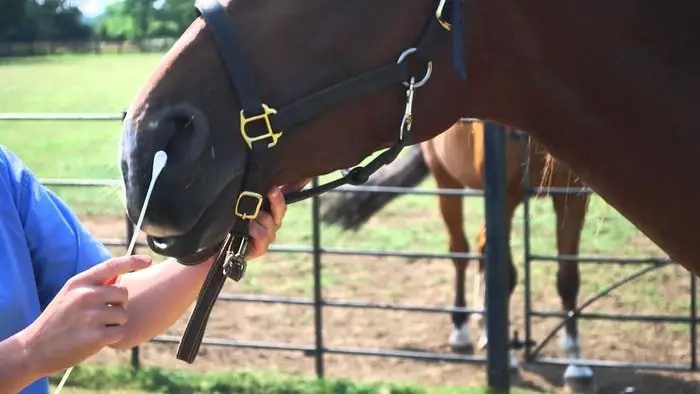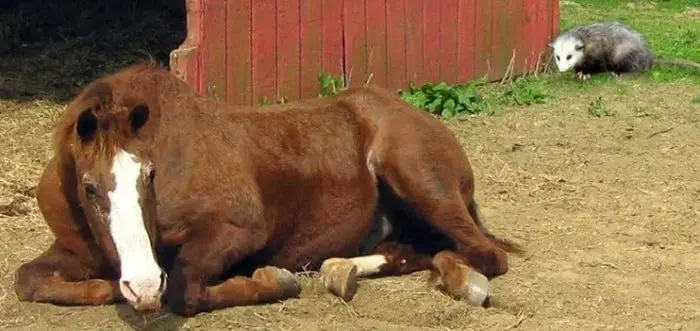Equine Rhinopneumonitis, also known as Equine Herpesvirus (EHV) infection, is a viral disease that affects horses, donkeys, and other equine species. It is caused by various strains of the equine herpesvirus, with two of the most common strains being EHV-1 and EHV-4. These viruses can lead to respiratory, reproductive, and neurological symptoms in infected horses.
EHV-1 and EHV-4 primarily target the respiratory system, causing nasal discharge, coughing, fever, and lethargy. In more severe cases, the disease can lead to pneumonia, which can be particularly problematic for young foals or horses with compromised immune systems.
Causes of Equine Rhinopneumonitis
Two strains of the equine herpesvirus primarily cause Equine Rhinopneumonitis: EHV-1 (Equine Herpesvirus-1) and EHV-4 (Equine Herpesvirus-4). These viruses belong to the family Herpesviridae and the subfamily Alphaherpesvirinae. They are responsible for causing a range of respiratory, reproductive, and neurological symptoms in equine species.
Here are some key points about the causes of Equine Rhinopneumonitis:
- Equine Herpesvirus-1 (EHV-1): This virus strain is known to cause various clinical conditions in horses. These include respiratory symptoms such as coughing, nasal discharge, and fever. Additionally, EHV-1 is infamous for its ability to cause more severe neurological symptoms, leading to equine herpesvirus myeloencephalopathy (EHM). This condition affects the CNS (central nervous system) and can result in incoordination, weakness, and paralysis.
- Equine Herpesvirus-4 (EHV-4): This strain primarily causes respiratory symptoms similar to EHV-1, including nasal discharge, coughing, and fever. While it can lead to respiratory disease, it typically doesn’t cause the same severe neurological symptoms as EHV-1.
EHV-1 and EHV-4 are highly contagious and can spread through direct contact with infected horses and indirect contact with contaminated equipment, feed, water, and human handlers. The viruses can also be spread through respiratory secretions from infected animals.
The incubation period for Equine Rhinopneumonitis is variable and can range from a few days to several weeks after exposure. The viruses can remain latent in the body after initial infection, potentially reactivating during stress, transport, or other factors that weaken the horse’s immune system.
Clinical Signs of Equine Rhinopneumonitis
Equine Rhinopneumonitis, caused by Equine Herpesviruses (EHV-1 and EHV-4), can lead to a range of clinical signs in affected horses. The signs can vary in severity, including respiratory, reproductive, and neurological symptoms. Not all horses infected with these viruses will exhibit all these signs, and the severity of symptoms can differ between individual animals. Here are the typical clinical signs associated with Equine Rhinopneumonitis:
Respiratory Symptoms:
- Nasal Discharge: Infected horses often have clear to yellowish nasal discharge.
- Coughing: Horses may develop a dry or moist cough.
- Fever: Elevated body temperature is typical and can range from mild to severe.
- Depression and Lethargy: Infected horses may appear listless and have reduced activity levels.
- Loss of Appetite: Horses might show a decreased interest in food.
- Sneezing: Frequent sneezing can be observed.
- Respiratory Distress: In severe cases, horses might show labored breathing and increased respiratory rate.
Reproductive Symptoms:
- Abortion: Pregnant mares infected with EHV-1 may experience abortion, typically late in gestation. This is a concerning aspect, especially for breeding operations.
Neurological Symptoms (Equine Herpesvirus Myeloencephalopathy – EHM):
- Incoordination: Affected horses might show incoordination and difficulty walking.
- Weakness: Muscle weakness, particularly in the hindquarters, can be observed.
- Difficulty Standing: Horses with severe neurological symptoms might struggle to stand.
- Paralysis: In severe cases, paralysis of the hind limbs might occur.
- Loss of Tail Tone: A dropped tail and reduced tail tone can indicate neurological involvement.
Diagnosis of Equine Rhinopneumonitis
The diagnosis of Equine Rhinopneumonitis (caused by Equine Herpesviruses – EHV-1 and EHV-4) involves clinical assessment, laboratory testing, and sometimes necropsy (post-mortem examination). Here are the key steps and methods involved in diagnosing the disease:
- Clinical Examination: A veterinarian will perform a thorough physical examination of the horse, paying close attention to clinical signs such as nasal discharge, coughing, fever, neurological symptoms (if present), and any history of abortion in pregnant mares.
- Nasal Swab or Blood Sample: Collecting samples from the nasal passages can help identify the presence of the virus. To detect viral DNA, nasal swabs can be tested using polymerase chain reaction (PCR) assays. Blood samples may also be analyzed for viral DNA or antibodies produced by the horse’s immune response.
- Serology: Blood samples can be tested for antibodies specific to EHV-1 and EHV-4. Serological tests can indicate if the horse has been exposed to the virus in the past or is currently infected.
- Viral Isolation: In some cases, viral isolation may be attempted by growing the virus in cell culture from nasal swabs or other samples. This method can help confirm the presence of the virus and its specific strain.
- Neurological Examination: A thorough neurological examination can help assess the severity and extent of neurological involvement if neurological symptoms are present.
- Abortion Investigation: In cases involving abortion in pregnant mares, the fetus and placenta can be examined to identify the presence of viral particles or other signs of infection.
- PCR Testing of Aborted Tissues: Tissue samples from aborted fetuses or placentas can be tested using PCR to detect viral DNA and confirm the involvement of EHV-1 in cases of abortion.
- Necropsy (Post-Mortem Examination): In cases where a horse has died, an autopsy can provide valuable information about the extent of disease involvement. Tissue samples can be collected and tested for the presence of the virus.
Differential Diagnosis of Equine Rhinopneumonitis
Equine Rhinopneumonitis (caused by Equine Herpesviruses – EHV-1 and EHV-4) shares clinical signs with several other equine respiratory and neurological diseases. To accurately diagnose and differentiate Equine Rhinopneumonitis from other conditions, veterinarians consider various factors, including clinical signs, history, laboratory tests, and imaging studies. Here are some of the differential diagnoses to consider:
Respiratory Diseases:
- Equine Influenza: This viral respiratory disease presents with fever, coughing, nasal discharge, and lethargy. It’s important to differentiate between influenza and Equine Rhinopneumonitis due to similar clinical signs.
- Strangles (Streptococcus equi infection): Strangles can cause fever, nasal discharge, coughing, and abscesses in the lymph nodes of the throat. It’s characterized by swollen lymph nodes, especially under the jaw.
- Equine Viral Arteritis (EVA): EVA can cause respiratory symptoms, fever, and swelling in the legs and scrotum in male horses. It can also lead to abortion in pregnant mares.
Neurological Diseases:
- Equine Protozoal Myeloencephalitis (EPM): EPM is caused by protozoa and can result in neurological symptoms similar to Equine Herpesvirus myeloencephalopathy (EHM), such as incoordination and weakness.
- Equine Motor Neuron Disease (EMND): EMND is a neurodegenerative disorder that can lead to muscle weakness and trembling.
- West Nile Virus (WNV): The WNV can lead to neurological symptoms such as stumbling, weakness, and paralysis.
Treatment of Equine Rhinopneumonitis
The treatment of Equine Rhinopneumonitis, caused by Equine Herpesviruses (EHV-1 and EHV-4), focuses on supportive care to manage the specific symptoms and complications associated with the disease. No specific antiviral treatment or medicine is available for these viruses, so the primary goal is to provide comfort and help the horse’s immune system effectively combat the infection. Treatment approaches may vary based on the severity of the clinical signs and the specific complications present. Here are some general guidelines for treating Equine Rhinopneumonitis:
Symptomatic Treatment:
- Respiratory Symptoms: Provide proper ventilation, maintain a clean environment, and use humidifiers to ease respiratory discomfort. Administer bronchodilators or anti-inflammatory medications to manage cough and nasal congestion.
- Fever: Use fever-reducing medications (antipyretics) under veterinary guidance to manage fever and promote comfort.
Neurological Symptoms (EHM):
- Neurological Support: Horses with neurological symptoms require careful monitoring to prevent further injury. Supportive measures, such as soft bedding, safe confinement, and assistance with feeding, might be necessary.
- Anti-inflammatories: Non-steroidal anti-inflammatory drugs (NSAIDs) might be prescribed to reduce inflammation and pain associated with neurological symptoms.
Aborted Mares (EHV-1):
- Medical Management: If abortion occurs, veterinary care for the mare’s health and post-abortion care may be necessary.
Isolation and Biosecurity:
- Isolation: Infected horses should be isolated to prevent the spread of the organism to other animals. Isolation helps control outbreaks and protect uninfected horses.
- Biosecurity Measures: Strict hygiene practices, such as disinfection of equipment, quarantine protocols, and hand washing, are crucial to preventing the transmission of the virus.
Nutrition and Hydration:
- Ensure infected horses receive proper nutrition and hydration to support their immune systems and well-being.
Veterinary Monitoring:
- Regular veterinary check-ups are necessary to monitor the horse’s progress and adjust treatment.
Prevention of Equine Rhinopneumonitis
Preventing Equine Rhinopneumonitis (caused by Equine Herpesviruses – EHV-1 and EHV-4) involves a combination of vaccination, biosecurity practices, and management strategies to reduce the risk of exposure and transmission of the virus. Here are key prevention measures:
Vaccination:
- Vaccination is an essential component of preventing Equine Rhinopneumonitis. While vaccines might not prevent all cases of infection, they can help reduce the severity of symptoms and limit the spread of the virus.
- Consult with a veterinarian to establish a vaccination schedule suitable for your horse’s age, health status, and level of exposure.
Biosecurity Measures:
- Implement strict biosecurity protocols to prevent the introduction and spread of the virus within your horse population:
- Isolate new arrivals for at least 2-3 weeks before introducing them to the rest of the herd.
- Limit horse-to-horse contact and avoid sharing equipment, water buckets, feed, and grooming tools between horses.
- Restrict access to communal areas such as arenas, wash racks, and trailers for sick horses.
- If attending shows or events, practice “home after the event” quarantine to prevent bringing back potential infections.
Hygiene Practices:
- Practicing good hygiene is essential to prevent disease spread:
- Wash hands thoroughly before and after handling different horses.
- Disinfect equipment, trailers, and vehicles that come into contact with horses.
- Regularly clean and disinfect stalls, water troughs, and feeders.
Monitoring and Surveillance:
- Be vigilant for any signs of illness in your horses, and consult a veterinarian promptly if you suspect Equine Rhinopneumonitis.
- Consider regular temperature monitoring for early fever detection, which can indicate infection.
Quarantine:
- Quarantine new horses before introducing them to the resident herd. A 2-3 week quarantine period allows time to identify any signs of illness before potential exposure to the existing population.
Management Strategies:
- Minimize stress and maintain a healthy immune system in horses, as stress can trigger latent infections. Provide proper nutrition, clean water, and a well-maintained environment.
- Avoid overcrowding and ensure adequate space between horses to reduce the risk of disease transmission.
Pregnancy Management:
- Pregnant mares should receive proper care to minimize the risk of EHV-1-associated abortion. Adequate nutrition and vaccination protocols for pregnant mares are essential.
Travel Precautions:
- If traveling with horses, minimize the risk of exposure to other horses and practice strict hygiene measures at shows, events, and equine facilities.
Concluding Remarks on Equine Rhinopneumonitis
Equine Rhinopneumonitis, caused by Equine Herpesviruses (EHV-1 and EHV-4), is a complex and multifaceted disease that can significantly impact equine health, performance, and the equine industry. It manifests with various clinical signs, including respiratory, reproductive, and neurological symptoms. The disease’s ability to spread rapidly within horse populations underscores the importance of prevention and management strategies.
EHV infections are highly contagious and can spread through direct contact between horses and indirect contact with contaminated equipment, feed, water, or human handlers. Horse owners and caretakers must implement strict biosecurity measures to prevent the spread of the virus.
Vaccines are available for EHV-1 and EHV-4, commonly used to help reduce the severity and spread of the disease. However, it’s important to note that vaccination might not prevent all cases of infection, and it’s just one part of a comprehensive disease management strategy.
Suppose you suspect that your horse may have been exposed to Equine Rhinopneumonitis or is showing any disease symptoms. In that case, it’s crucial to consult a veterinarian for proper diagnosis, treatment, and guidance on preventing the spread of the virus to other animals.

